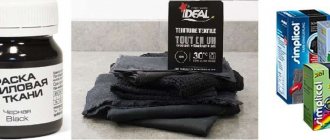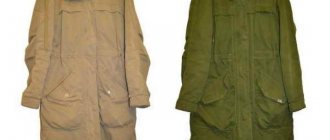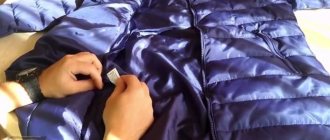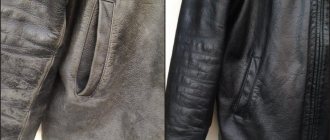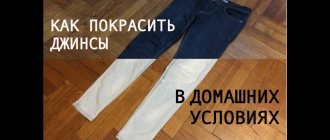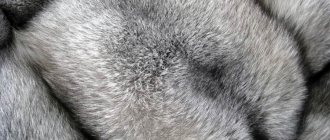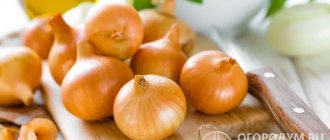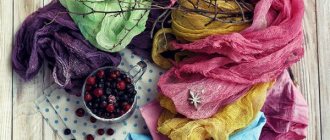How to dye clothes at home yourself is most often puzzled by creative, restless, or zealous housewives who want to save money on everything. To solve such issues, you need to choose a special paint for fabric, or experiment with natural dyes, which are usually abundant in our kitchen and refrigerator. This includes tea, coffee, berries, and plant leaves. The main thing is not to be afraid, follow the instructions and act carefully.
The process of painting tulle and clothes with brilliant green
When dyeing light-colored products with green, the color will turn out green. The saturation of the tone depends on the added consistency of the drug and the time the clothes to be dyed are kept in the solution, so before carrying out the procedure it is necessary to think through all the details.
If fabrics are exposed to a mixture of a highly concentrated product in large quantities, they will turn dark green. If you keep them for a long time, it will become much darker. In a weak solution, the products will be pale greenish.
Before the procedure, textile fabrics, tulle or clothing are washed and dried. They must be clean and free of stains. Running water is heated to room temperature +26…+30°C. A short, wide in diameter, old, unnecessary container is suitable for processing the material; at the end of the process, it may lose its color.
Before painting, the tulle must be washed and dried.
You need to dye textile items with your own hands as follows:
- Pour warm water into the container.
- Wear gloves.
- Add the previously prepared 1% alcohol solution of brilliant green. The composition is determined independently. According to practical information, to obtain a good result, use 10-20 ml of medical product per 5 liters of water. If the product is large, for example nylon mesh or tulle, the proportions are increased.
- Stir the liquid well until it has a homogeneous consistency; you can strain it through cheesecloth.
- Place the wet material to be painted into the working solution. If there are several items, they are processed separately.
- Periodically turn them over in containers, distribute the folds.
- Leave for 20-30 minutes.
- Rinse in a weak solution of table vinegar or in cold water with added salt or soda. This will help fix the color and keep it for a long time.
- Evaluate the result on a dry cloth. Wet materials are much darker.
The method of using brilliant green for painting is considered simple, safe, environmentally friendly and economical. It does not take much time or labor, and the costs are minimal.
When the green effect is enhanced, re-dying is possible, and the fabric does not crack or tear after treatment.
Dyeing process
You can dye clothes in different ways: by boiling or soaking.
By the way, if you decide that it is easier to buy a ready-made pigment, we have prepared an article for you with a detailed description of how to dye fabric with a ready-made dye at home.
So, back to homegrown dyes.
Recommendations regarding the preparation of dishes, water, etc. coincide with those when using ready-made pigments.
As for the preparation of the coloring solution, there are some nuances here, we will analyze them below.
Coloring with fresh natural dyes.
Coloring with fresh berries, fruits, vegetables or herbs comes down to the following steps:
- Making juice or puree. When using fruits and some vegetables, such as carrots, it is better to prepare the juice using a juicer. If this is not possible, then grind in a blender until pureed. Also, it is more advisable to prepare puree instead of juice from berries and herbs.
- Making a quick decoction. Dilute juice or puree with water to the desired saturation, add salt at the rate of 1 tbsp. per 1 liter of solution. Boil for 5 minutes.
- Let cool slightly and strain through double cheesecloth.
- The fabric is soaked for 12-24 hours, dried and the shade is fixed with an iron or etchant, if this has not been done before.
From fresh berries, vegetables, fruits and herbs you need to make juice or puree in a blender for dyeing fabrics
Coloring with dried herbs and fruits
In the case when dry berries, herbs and flowers are used, the first thing you need to do is make a decoction with the addition of salt at the rate of 1 tbsp. per liter of liquid. To do this, they are boiled for 0.5 - 2 hours in water. Then everything is the same: we strain, soak or boil the clothes, dry them, iron them.
Regarding boil dyeing, we do not recommend preparing a decoction and immersing the fabric at the same time, unless this is done intentionally. In this case, multi-colored spots may appear due to the uneven distribution of pigment in the solution.
It is necessary to prepare a decoction from dried herbs and flowers for further pigmentation of clothes
General principles of dyeing fabrics at home using improvised means
Before you start painting something, you should make sure that it can be painted. To do this, you need to familiarize yourself with the information about the composition of the fabric located on the label. Materials containing natural fibers (linen, cotton, bamboo, wool) are suitable for painting. Dyeing a completely synthetic product can lead to unpredictable results. Some tips for dyeing things at home:
- the product must be clean and dry, washed without using conditioner;
- In order for the shade to turn out pure, it is better to use white things for dyeing or those similar in color to the desired one (for example, it’s easy to make a bright blue T-shirt from a pale blue T-shirt);
- if the purpose of dyeing is to disguise a difficult stain, then it is better to give preference to blue or black dye;
- Before using the dye, you should wet the fabric with water using a spray bottle (soaking and then squeezing is prohibited, as this will result in creases).
Many manufacturers place a piece of fabric next to the label that is identical to the one from which the clothing is made. If this scrap is preserved, it must be used for test staining. This way you can make sure that the shade you want will be the desired one, otherwise you can change the concentration of the coloring solution.
Recommendations for dyeing clothes and tulle:
- The most important and main advice. Before you start directly painting clothes, weigh the pros and cons. Amateur painting is always a risk.
- Know the composition of the fabric, because the entire painting result depends on the composition of the fabric:
- if the fabric is natural, for example: cotton, linen, denim, then, as a rule, dyeing goes well;
- if the fabric is mixed, the color will come out a little paler, for example, it will not be blue, but light blue.
- if the fabric is 100% synthetic, there is a very high risk that the fabric will not dye at all, because with synthetic fabrics, the paint flows off like cellophane, and the product will remain exactly the same shade as before dyeing.
Important! Please note that, unfortunately, at the moment there are more and more cases when the composition that is written on the label does not coincide with reality.
- Decide on a color. We recommend dyeing in colors that are slightly darker than the original shade of the fabric. For example, blue is best painted blue or dark blue. Also, do not forget to take into account the original shade of the item. The ideal option is if they are similar colors. But if you dye white jeans black, you will end up with gray or dark gray, but not black.
- Only judge the final shade on a thoroughly dried dyed item, because wet items are always darker.
- If color is very important to you, dye a test piece of fabric that will be the same in composition, dry it and look at the result.
- If you don’t like the shade of the paint you prepared, it’s better not to risk it. In industrial conditions, shades of paint are tested a large number of times, achieving the required color. At home, you only have 1 try.
- Paint only with gloves on. Wear gloves before opening the paint package if you decide to use an industrial solution rather than the options we offer. When working with medical solutions, also do not ignore gloves, so as not to think later about how to wipe off brilliant green or potassium permanganate from the skin.
- Paint items according to the instructions written on the packaging when using industrial dyes.
How to dye white fabric using brilliant green and other dyes?
Tulle and curtains are accessories that people notice when they enter your room. Fabric curtains can both decorate and hopelessly ruin your entire interior.
Painting curtains a different color quickly and without any special effort is one of the acceptable options for transforming the appearance of a room. By changing the color scheme of clothes for windows, as well as choosing cute things to match, you can get a new solution for your home or work environment.
Do-it-yourself painting of tulle and curtains can help you if you don’t have the funds or time to update the interior and make repairs, but your soul is asking for something new. The painting process is very economical in every sense, because:
- no significant cash outlay is required to purchase dyes;
- it is not necessary to waste your time waiting, and also listen to the designer’s recommendations;
- there is no need to walk for a long time from store to store in search of new materials;
- There is a possibility of re-painting.
Home conditions are suitable to give your window wardrobe a new look on your own. Let's take a step-by-step look at the process of how to paint fabric with brilliant green and other equally interesting means at hand. Moreover, this fabric can be the basis of both interior decor and your clothing.
Dyeing fabrics with vegetable dyes
Once the choice has been made in favor of a specific dyeing component, you need to figure out how to dye the fabric with your own hands.
The process of coloring fabrics with plant pigments includes 2 stages: etching and, in fact, dyeing.
Fabric etching
Etching of fabrics is carried out in order to fix the paint on the fabric and enhance the brightness of the pigment. In some cases you can do without it. For example, if you need to add a slight tint to white things. If you need to radically repaint textiles, then you cannot do without preliminary preparation.
The question arises, where can we get the necessary chemicals for this process? Our searches led to pharmacies and specialty chemical stores.
You can get acquainted with the features, purpose and composition of various etchings in the table below.
Table of Chemicals for Fabric Etching
| Type of fabric fixative | Features of application | Recipe per 100 g of tissue |
| Potassium alum | It is used in the case of obtaining light shades: yellow, lemon, brown, bright red. When pickling, formic or oxalic acid is added (alum - 15%, acid - 5% of the weight of the yarn). | 2-3 liters of water and 4g of alum |
| Copper sulfate (copper sulfate) | Used to produce dark yellow, grey, greenish and brown shades | 2-3 liters of water and 1 g of copper sulfate |
| Glauber's salt (sodium sulfate) | Universal etching. Allows for uniform color | 2-3 liters of water and 1 g of salt |
| inkstone | It is used when it is necessary to obtain dark shades: gray, brownish-green, black, reddish-brown. | 2-3 liters of water and 0.5 g of iron sulfate |
Important! The choice of fixative affects the resulting color. Thus, the use of one type of natural pigment with different etchants gives different colors. The final result is also influenced by the concentration of the fixative, the decoction and the pickling method.
Types of etching:
- Pre-etching
The fixative powder is dissolved in a small amount of water and poured into main water heated to 40 degrees. Wet fabric or yarn is dipped into the solution and brought to a boil. Boil for 15-20 minutes, stirring. Then the fabric is removed and immediately dipped into a lukewarm decoction of the dye.
- Simultaneous with coloring
This is the easiest etching method. As in the first case, the fixative is dissolved in a small amount of water and poured into the decoction. Everything is thoroughly mixed and the clothes are put down.
- Post-etching
It is carried out after dyeing at the end of the procedure. Pour the etching concentrate into the decoction with the dyed fabric that has cooled to 35-40 degrees. Boil over low heat for 30 minutes. After cooling to 60 degrees, the items are removed and rinsed.
Etching fabric before painting
Etching with improvised means
You can try replacing the etching by boiling it in a solution using improvised means. The following options are possible:
- A good effect of uniform coloring and color fastness is obtained by preliminary boiling in alkaline water with soda. To do this, make a solution in the proportion of 2 grams of soda per liter of water and add a little soap or liquid powder. Boil the clothes in this liquid for 20 minutes. Then the things need to be rinsed and that’s it, they are ready for pigmentation.
- When dyeing clothes with berries, it is necessary to prepare a saline solution in the proportion: water/salt 20:1. Then put the cloth and simmer over low heat for about an hour.
- If you dye vegetables with fruits, for example, beet broth, then the clothes are first placed in a vinegar solution. To do this, add 1 part vinegar to 4 parts water. Place the cloth and cook over low heat for about an hour.
The story of our “diamond”
Let's go back to the 19th century and the development of the weaving industry. Chemists created dyes that could not be removed from clothes. These dyes were useful in the weaving industry and also for doctors, who, in turn, stained preparations with these dyes in order to better see the vital activity of the microorganisms being studied.
And suddenly, experts found out that it is “diamond green” (zelenka) that destroys microbes. Then the doctors thought, it’s too expensive to bring antiseptics from abroad, and plus there is a deficiency in iodine, we have a new universal remedy - brilliant green dye for fabric, and why check it? Everything works just like that!
The dye was additionally mixed with alcohol and water and sent for sale. From that moment on, the time began for an antiseptic remedy for all diseases - brilliant green.
Light shades
Just to give light fabric an interesting shade, it is not at all necessary to use professional paints. Some available means are quite suitable for this purpose. For example, those described below.
Tea and coffee
How to dye tulle beige? For those who are not ready for radically bright colors, there is an option to give the fabric a neutral, but at the same time quite beautiful shade. It can be cream, ivory or the same beige.
Your actions are very simple:
- Wash the tulle in advance (preparatory stage).
- Brew 1-2 tablespoons of tea in 1.5-2 liters and let the liquid brew.
- Strain it.
- Leave your fabric in the solution for half an hour to forty minutes.
- Rinse well and dry it.
Important! This method is ideal for cream shades. If you intend to get beige tulle, then follow the same steps, replacing tea with coffee.
Potassium permangantsovka
This substance is ideal if the desired result is a pink or purple tint. All you need to do is dilute the crystals with water, and the concentration of the solution depends on how rich the tone of the fabric you want to get.
Important! Do not use large amounts of laundry detergent or any other cleaning product as this may cause the fabric to color unevenly. Take this nuance into account.
Zelenka
How to dye fabric with green paint at home is as easy as shelling pears. The end result is a lovely light green color. In addition, this method will take very little time, like other coloring options.
Instructions for use are the same as in the methods indicated earlier. That is, dilute the brilliant green with water and soak the fabric in it.
Important! It is important to remember only one thing - the exposure time directly depends on how bright the shade you want to get in the end.
How to dye old towels?
How to dye a towel at home:
- dilute permanent paint according to instructions;
- pour 10 liters of water and boil;
- Throw a towel into boiling water and cook for an hour until the fabric turns a different color;
- rinse thoroughly several times in warm and cold water;
- fix the result with vinegar.
Interesting materials:
How to find out the balance for MTS cable TV? How to find out what was copied before? How to find out what was on the clipboard in Windows 7? How can you tell if your newborn is freezing? How to find out what is draining your Android battery? How can you tell if a bearing is making noise? How do you know if you've been banned from Twitter? How can I find out the creation date of a file? How to find out the day of death by date of birth? How to tell porcelain or glass?
How to paint
We take the selected plant material, grind it and boil it in distilled or rain water. If possible, add potash. The solution must be evaporated until it acquires the required concentration and color. We filter the dye solution, and then boil the fabric in it (the procedure time depends on the desired shade). Fabric dyed with natural dyes should not be washed (or do it VERY carefully and with gentle detergents) if you do not want it to lose its color or acquire unintended stains.
How to dye fabric with beets
Beetroot gives white fabric a beautiful pink-raspberry color, and beige fabric a richer peach tone.
The procedure for coloring beets comes down to the following steps:
- Preparation of the coloring solution. Peel 3-4 large raw beets, rinse well and cut into large cubes or slices. Immerse in water poured into a saucepan or other container that can be kept on fire and where the painting process itself will take place. There should be enough water for complete immersion and free distribution of clothing, without strong creases or compression. The more beets you cut, the richer the color you will get. Next, add salt to the water at the rate of 1 tbsp. for 2 l. water and boil everything over low heat for 2.5 - 3 hours. After which the beets are caught in a colander. It is also advisable to strain the resulting dye through cheesecloth.
- Dyeing. Once the solution is obtained, you can immerse the clothes. It is painted using the soaking method for 12-24 hours. The longer the clothing sits, the richer and more stable the color will be. During this time, the fabric must be turned over and the solution mixed several times to evenly distribute the pigment.
- Drying. The clothes are taken out, the water is gently squeezed out without twisting and straightened on a hanger. It is advisable to dry such fabric outside in the sun. This consolidates the result.
- Fastening with an iron. Completely dry clothes are ironed on a gentle cycle (wool, silk, nylon) without steam.
Dyeing clothes with beets
How to dye a piece of clothing with colored liquids, what color do they give?
Among the available means for dyeing clothes, solutions such as brilliant green, iodine, fucorcin, and potassium permanganate are used. The last two are used when it is necessary to give things a pink or crimson color. Zelenka will give a grassy tint, and iodine will give a brown or orange tint. It all depends on how saturated the prepared solution is.
Zelenka (diamond green)
How to dye fabric with green paint? To do this, the pharmaceutical product is diluted in warm water. You need to choose the concentration yourself, depending on the saturation of the desired shade. On average, take 1 bottle (10 ml) of brilliant green per 5 liters of water. After this, you need to mix the solution and carefully place the pre-moistened product into it. Leave for half an hour, periodically turning the item over. To protect your hands, you must wear gloves before the procedure.
Iodine solution
Iodine is a yellow-brown antiseptic solution. Fabric dyeing with this product is done in a similar way to brilliant green. For 5 liters of water, take 1 bottle of iodine solution, mix everything. To get a more saturated brown tint, you will need 20–30 ml of iodine solution (5%). The longer you keep the item in the resulting liquid, the darker the color it will become.
Potassium permanganate or fucorcin
Potassium permanganate and fucorcin are antiseptic agents that have a pink tint. Another name for fucorcin is “Castellani paint”. When using the product to dye fabric, mix 10 ml of alcohol solution with 5 liters of water in a container and place the textile product there. Leave for half an hour, periodically turning over and checking the shade. To obtain a soft pink shade, the item is kept for about 5–10 minutes; to achieve greater brightness it will take more than an hour.
To consolidate the result, you need to immerse the painted product in a vinegar solution. To do this, you need to dissolve 9 percent table vinegar in 3 liters of water and place the item in the solution for 15 minutes. Then the product is carefully wrung out and ironed through gauze. The final stage is a delicate wash at 30°C using fabric softener.
When using potassium permanganate crystals, you need to dissolve them in boiling water (for 1 liter of water you need to take 1 teaspoon of potassium permanganate). In the future, proceed in the same way as with fucorcin.
Dyeing and bleaching fabrics using potassium permanganate
Any needlewoman, especially one who sews dolls and toys, is faced with the fact that from time to time she has to dye the fabric so that its color resembles the natural color of the skin.
And in stores you can’t always find the right shade. The easiest way to dye fabric is to dye it with natural dyes. Today we will look at several options for dyeing fabric with natural dyes. How to dye fabric using tea.
You will need: fabric; pot; water; black tea; brush.
1. Take a large saucepan, or any container. Pour water into it and bring to a boil. Place a few spoons of black tea in boiling water. You can use bags (about 10 pieces). Prepare the solution, stir it constantly. Strain the tea through a sieve. If you used bags, then fish them out and throw them away. Be sure to add a little salt (1 teaspoon) to the water so that the paint does not peel off the fabric. Cool the solution a little.
2. Take the fabric you want to dye. If it's clothing, then remove all items from your pockets. Place it in water and cook for one hour. Stir the fabric constantly so that the paint is applied evenly. If you take a hotter solution with tea, then it will give the fabric a more saturated color, and a less hot solution will give a less pronounced shade. The fabric will lighten as it dries.
3. Remove the material from the solution, rinse first in warm and then in cool water until the liquid is clear. Squeeze a little, shake well. Make sure the fabric is all straight. Hang it to dry. After it has completely dried, iron it well.
4. To achieve a stained effect on fabric, you can paint it with a brush. Brew strong black tea and apply the solution to the fabric with a wide, flat brush. Draw any picture. To make the stains brighter, place a small napkin under the fabric to be dyed. A little liquid will be absorbed into it, and when it dries, it will come out on the surface of the fabric. Air dry the fabric, or use a hair dryer.
5. You can put tea leaves on it, the fabric underneath will still be tinted. Create a stripes or squares effect. Cover different areas of the fabric with adhesive tape, or apply pieces of paper.
Helpful advice
When dyeing, use different brands of tea; they will give the fabric different shades and density of color.
Taken from kakprosto.ru/kak-75105-kak-pokrasit-chaem-tkan
A few more tips from Elena Ruko.
How to dye fabric using manganese
Very durable coloring. Things painted with potassium permanganate have been washed many times and the color does not wash off.
Ikea white Lenda was used again.
I poured just a little manganese into warm tap water, and the solution turned out to be a dark cherry color. Mix well to dissolve. I put pieces of fabric. I took it out immediately, after 1,3,6,10,20 minutes, then after 1,2,3 hours (remember to stir).
I dipped more double pieces, colored for 1 and 2 hours, into the turmeric solution. Then I dried it, ironed it and designed everything on a sheet of paper.
Manganese gives a good color, and with turmeric you can make it a little yellower, it turns out nice.
Source
Tips for dyeing fabric products in an automatic machine
You can dye white fabric not only by hand, but also in an automatic machine.
Before you start dyeing clothes or tulle with brilliant green in an automatic machine, follow all the recommendations for preparing for this procedure.
Before treating with brilliant green, you need to familiarize yourself with the basic recommendations for staining:
- The working solution is prepared in a separate container, and not in a washing machine.
- The diluted mixture is poured into the drum of the unit.
- The water is heated to +60…+70°C.
- Do not pre-soak clothing or other textile products.
- Set the longest working time in the machine.
- Do not add conditioner or laundry detergent.
- After dyeing, the washing machine turns on the rinse mode to completely clean the internal parts of the unit and wash out any remaining dye.
- After finishing the treatment, it is not recommended to wash light-colored items.
- Repainted products are rinsed in a solution of table vinegar to fix the diamond coloring agent.
Traditional methods in the fight against potassium permanganate on the skin
A good result can be obtained using the following well-known and accessible folk methods for removing traces of potassium permanganate from the skin:
Hydrogen peroxide and vinegar
A good helper in removing traces of potassium permanganate is a homemade solution consisting of vinegar and hydrogen peroxide. These substances must be mixed in equal proportions and the prepared solution wiped over the skin using a cotton pad.
Medical alcohol
Take a cotton swab, moisten it generously with alcohol and apply it to the marks of potassium permanganate. Repeat this several times.
A little about secrets...
Lemon
Take a medium-sized lemon, cut it in half, rub it on the stained skin, and wash off the remaining lemon juice with soap and water. Instead of lemon, you can use citric acid by diluting it with water: you will need a teaspoon of acid for ½ cup of warm water.
Ascorbic acid solution
This remedy will help reduce the intensity of purple spots resulting from exposure to potassium permanganate on the skin. It is enough to wipe the marks on the skin several times a day with an ascorbic acid solution purchased at the pharmacy.
Hydrogen peroxide
By using pure 3% hydrogen peroxide, you can quickly get rid of pink spots on your body. However, it must be used extremely carefully, otherwise you can get a chemical burn. Considering the unsafety of the product used, it is not worth removing traces of potassium permanganate in children using hydrogen peroxide.
Nylon tulle
How to paint nylon tulle? There are a large number of methods and tips for dyeing nylon fabric. Our grandmothers and great-grandmothers also used them.
Choose one of the options that suit you:
- The method that requires corrugated paper is one of the simplest. The result will pleasantly surprise you. Cut it into small pieces and fill it with water. Let it brew. Soak the fabric in the resulting colored liquid.
- Potassium permanganate and tea and coffee work great here, and you can also paint the tulle with brilliant green.
- Special dyes for nylon, wool or cotton fabric are well suited. But the dye for silk will not work.
Important! You can use all these methods not only to change the shade of the curtains, but also to modify tights or stockings in accordance with the intended image.
Advantages and disadvantages of natural dyes
Before deciding on the choice of homemade pigment for clothing, you need to take into account the fact that homemade products are suitable primarily for dyeing natural fabrics such as cotton and linen. As for synthetics, there are special ready-made dyes for them.
Natural dyes are only suitable for dyeing natural fabrics or those with a minimal content of synthetic fibers.
You can highlight your pros and cons when dyeing clothes at home using fruits, herbs, vegetables, spices, tea, coffee, etc.
The advantages include:
- Budgetary procedure. Many improvised dyes, such as beets, onion peels, etc., are much cheaper than ready-made synthetic dyes. True, for dyeing fabrics, in most cases, you need special mordants, which you still have to additionally search for and buy.
- Housewives note the color stability when using natural pigments.
- The relative safety of most homemade dyes. This applies to a greater extent to natural components. If you decide to dye your clothes, for example, with potassium permanganate, you need to act very carefully, because... it belongs to explosive substances.
Natural dyes are a safe and natural product for dyeing fabrics.
The main disadvantages of the procedure are:
- The complexity of the procedure. If you buy a ready-made composition, then the method of diluting it is usually extremely simple. In the case of using improvised means, for example, it is necessary to make a decoction, squeeze out juice, etc. This somewhat lengthens the procedure for dyeing fabrics. In addition, when using natural dyes such as berries, leaves and flowers of plants, fabric etching is necessary, which further lengthens the dyeing process.
- A certain unpredictability of the result. Homemade dyes cannot definitely guarantee the shade as “in the picture.” For example, the same fruit, depending on the time of year, may contain different amounts of pigments, which will affect the color saturation of clothing. Therefore, it is recommended to test the homemade mixture on a small area of fabric.
Dyeing clothes with improvised means does not always give a predictable result!
Folk remedies
Natural paints include mint (for green), beets (for red and pink), activated carbon and other products containing a large amount of pigment.
Machine painting
But since in modern times there is a large selection of dyes for clothes, almost no one uses such recipes. In the past, many women would boil jeans or outerwear for several hours to give the item a fresh look.
Other dyeing methods
There are quite a lot of them. Moreover, coloring can be done either manually or by machine. Here are some of them:
- Yellow color can be obtained by using all the different yellow flowers as coloring agents. For example, dandelions, daffodils and calendula.
- Carrots and onion peels will help to acquire an orange tint.
- If you want to get a green color, then, in addition to the usual greenery, you can also use the leaves and stems of sorrel, yarrow and spinach.
- Blackberries will give the tulle a black color.
Important! A good option is to apply a fixative to the tissue before starting the procedure. It will help fix the color and preserve it during subsequent washes of the tulle.
Preparing a tulle curtain for painting
The preparation process is practically no different from regular washing. The washing temperature should not exceed 30 °C for synthetic fabrics and 40 °C for natural ones.
Important! Additional attention should be paid to:
- shaking out the curtain before washing so that there are no small specks left that can prevent uniform coloring;
- gentle spin, it is better not to squeeze at all, let the water drain: creases will also prevent the uniform distribution of color.
How to dye arctic fox fur at home
Arctic fox fur lends itself well to dyeing. If you want to upgrade your Arctic fox item, you will need:
- hair dye;
- fatty cream (can be replaced with glycerin);
- hair balm;
- rubber medical gloves;
- a brush or an old toothbrush for applying the coloring composition;
- vinegar.
- Lubricate the inside with cream.
- Stretch the material on a flat surface and secure it.
- Thoroughly moisten the previously cleaned surface with water.
- Wear gloves and quickly apply the coloring composition, smoothing the pile with your hand.
- Wait for the period of time specified in the dye instructions.
- Rinse the lint under running warm water and rinse in a vinegar solution.
- Treat the item with balm diluted in water and rinse.
- Lubricate the inside again with cream, carefully stretch it, pin it with pins, and let it dry.
Canvas color is green.
Zelenka is an emerald green antiseptic solution. In production it is used as a dye for cotton and silk.
The canvas was painted in a glass container. Zelenka was added to boiling water at the rate of 300 ml of boiling water per 2 ml of brilliant green. Pieces of canvas were placed there and soaked in a dye solution for 2, 5, 10 and 20 minutes. Next, the canvas was rinsed in warm water and soaked for 20 minutes in a vinegar solution: 1 liter of water per 2 tablespoons of vinegar. After this, the sample was embroidered with white threads, the fabric was again washed, ironed and sent to the window. Each stage of work is presented in the table.
| Dyeing time | Coloring result | Sample embroidery, washing, ironing | Window |
| 2 minutes | |||
| 5 minutes | |||
| 10 minutes | |||
| 20 minutes |
Dyeing and bleaching fabrics using potassium permanganate
Lately, I quite often come across information about dyeing fabrics at home. Indeed, this topic is quite relevant for embroiderers. There is a huge selection of white canvas in stores; black or cream is less common. If a colored base is needed for embroidering a motif, then finding it presents certain difficulties. In this article I want to tell you about my experiences in painting canvas at home.
The purpose of my experiments is very simple. I want to find out whether it is possible to achieve high-quality canvas coloring at home. For the first part of the experiments, I use dyes from the first aid kit: brilliant green, fucorcin, iodine and potassium permanganate. These products are very common and are often used as dyes in everyday life. All experiments were carried out with Aida canvas by PNK Kirov. Each piece of canvas was subjected to the following procedures:
- dip dyeing
- fixing color in vinegar solution
- ironing
- embroidery pattern with white threads
- washing: put pieces of canvas in warm water for 5 minutes, then took them out.
- ironing
- window: each piece in a file or under film and on a shaded window.
